Stow, Suffolk
Up to 1834
In 1778, the Stow Hundred Incorporation was established by a local Act of Parliament For the better Relief and Employment of the Poor within the Hundred of Stow, in the County of Suffolk (18 Geo.3 c.35). The Incorporation was granted powers to administer poor relief on behalf of its fourteen member parishes which comprised: Buxhall, Combs, Creeting St. Peter, Great Finborough, Little Finborough, Harleston, Haughley, Old Newton, Onehouse, Shelland, Stow Upland, Stowmarket, and Wetherden.
By 1781 a House of Industry known as "The House for the Poor of the Hundred of Stow" had been erected at Onehouse near Stowmarket at a cost of £1,200.
A house on Upper Street in Rattlesden was once the parish workhouse.
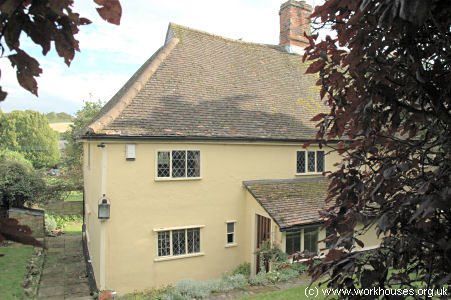
Rattlesden former parish workhouse, 2006.
© Peter Higginbotham.
After 1834
The workhouse was taken over by the new Stow Poor Law Union which came into existence on 24th October 1835. Its operation was overseen by an elected Board of Guardians, 32 in number, representing its 31 constituent parishes as listed below (figures in brackets indicate numbers of Guardians if more than one):
County of Suffolk: Ashfield Magna, Badwell Ash, Beyton or Beighton, Buxhall, Combs, Creeting—St Peter or West, Drinkstone or Felsham, Elmswell, Great Finborough, Little Finborough, Gidding, Gipping with Stowmarket, Harleston, Haughley, Hunston, Kessett, Langham, Old Newton with Dayworth, Norton, One-House, Rattlesden, Shelland, Stowlangtoft, Stowmarket (2), Stow Upland, Thurston, Tostock, Walsham-le-Willows, Wetherden, Woolpit.
The population falling within the Union at the 1831 census had been 16,846 with parishes ranging in size from Little Finborough (population 73) to Stowmarket (2,672). The average annual poor-rate expenditure for the period 1833-35 had been £13,632 or 16s.2d. per head of the population.
An Assistant Poor Law Commissioner visited the new Union and was surprised that the 'Stow Hundred-house had so palatial a character'. Replies to his enquiries attributed this to it 'being situated in the immediate vicinity of the country seats of some of the directors, who were naturally inclined to adorn rather than disfigure the landscape. The future subject of chagrin had not been anticipated; the Hundred-house eclipsed some of the neighbouring mansions.'
Like the Hundred house at Samford, Stow had a large U-shaped main building. Its location and layout are shown on the 1903 map below.
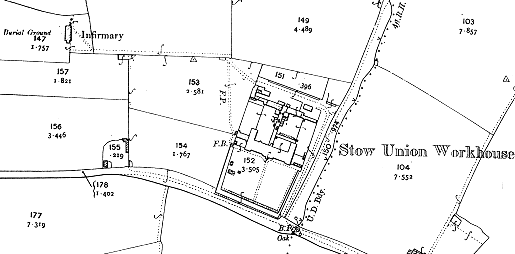
Stow workhouse site, 1903.
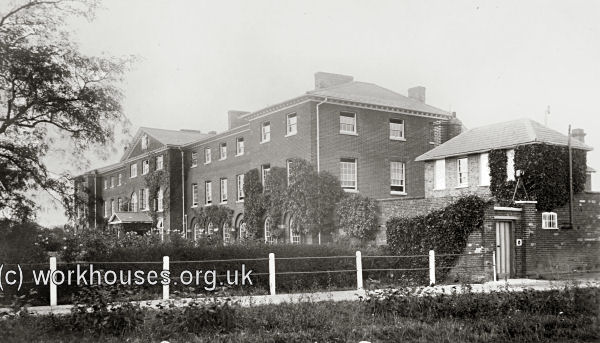
Stow main building from the south-east, early 1900s.
© Peter Higginbotham.

Stow main building from the south, 2001.
© Peter Higginbotham.
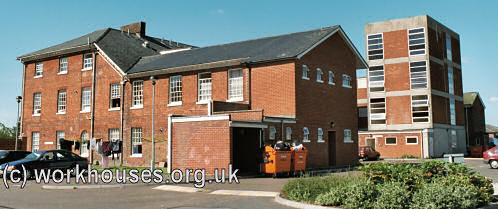
Stow main building from the north-east, 2001.
© Peter Higginbotham.
There is sundial of unknown date above the main entrance which includes the motto "ORIMVR MORIMVR" [We rise, we die].
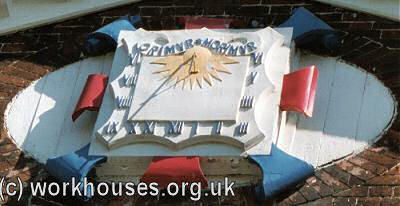
Stow sundial from the south, 2001.
© Peter Higginbotham.
The workhouse later became Stow Lodge Hospital which closed in 1991. The site has now been converted to residential use.
Children's Home
By 1908, the Stow Union was operating a children's home at 18 Bury Street, Stowmarket. It could then house 23 children, with Miss E Macdonald as its Superintendent.
In the mid-1920s, the home moved to a large property known as Hill House, located at the east side of Violet Hill Road. In 1929, the home could accommodate 50 children. After 1930, the home was later taken over by Suffolk County Council and became known as Eastward Ho In more recent times, the building was renamed Evelyn Fison House and was used as offices by Suffolk Social Services until 2003. In 2006, the building was standing empty.
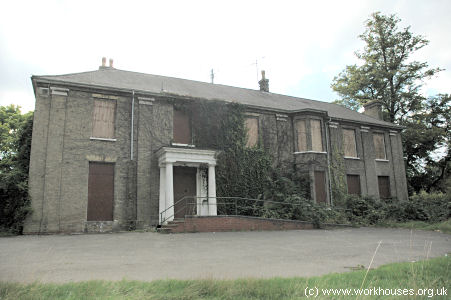
Stow's Hill House / Eastward Ho children's home, 2006.
© Peter Higginbotham.
Staff
Inmates
Records
Note: many repositories impose a closure period of up to 100 years for records identifying individuals. Before travelling a long distance, always check that the records you want to consult will be available.
- Suffolk Archives, The Hold, 131 Fore Street, Ipswich, Suffolk IP4 1LR. Holdings include: Minutes (1778-1930); Relief order books (1785-1872); Bastardy papers (1729-1825); Weekly state of the poor (1821-46); Births and deaths (1831-35); Admissions and discharges (1860-1); Punishment books (1856-1930); Letter books (1843-96, 1902-4); etc.
Bibliography
- Higginbotham, Peter The Workhouse Encyclopedia (2014, The History Press)
Links
- None.
Unless otherwise indicated, this page () is copyright Peter Higginbotham. Contents may not be reproduced without permission.


